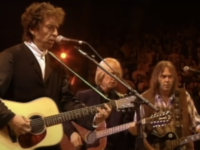There’s nothing quite like the Waterboys’ Where the Action Is in terms of context, content or reference. From rock and roll to stories to listen to, this album is stuffed full of different cultural references, influences and styles.
Out this month on Cooking Vinyl, Where the Action Is opens with the title track – a great re-working of Robert Parker’s original number. Parker played this straight, with regular, minimal chords whereas the Waterboys offer a noisier, busier and far more emotive interpretation of the lyrics. Strong back-up singers underpin Mike Scott’s lead vocals superbly and the interjection of additional lines at the open and close create a rocking, well-structured demon of a song.
“London Mick” is a tribute to Mick Jones of the Clash, and the guitar work on this number is played in Mick’s style, redolent of the punk era. Strong vocals and writhing Hammond also wrap around the words make this a wonderful track. The lyrics are written from a fan’s perspective, telling Jones’ story – leaving, taking stick and adding: “He aced [the late Joe] Strummer with his killer licks; you were my guitar hero, London Mick,” amid well-shaped chords. A pounder of a track, this ’70s-style rendition would go down a treat in any crowded venue today.
“Out of All This Blue” is a story of sadness, empathy and comfort being offered. This was written for a friend who was going through a bad patch, which is why perhaps there are clear references to the traditional Scottish tune “The Water is Wide (O Waly Waly)” – a song of comfort, which many children know as they grow up. There is love and compassion in waves here.
That’s followed by “The Right Side of Heartbreak (Wrong Side of Love),” a rocky Waterboys ballad focusing on the dangers of hanging back in a relationship, for fear of being hurt. Lyrics such as “You’re half crazy with desire, you crave a love to touch your soul; but you hide your inner fire with impeccable control” are delivered against a brilliantly structured counterpane of sound. This understated track was recorded by Scott at home on guitar into a single microphone and again sent to Brown, who added beats and effects at his studio in Nashville.
“In My Time on Earth” is different and speaks of divine mystery, and secrets of the heart. It’s emotive and raw, as the Waterboys search through the values we possess and the short, but valuable time we have. “The man on the screen is an actor and a fake, yet he preens like a golden superstar,” Scott sings, “and the word on the tip of a thousand million tongues went unspoken as a lie sped everywhere.” This is a song of despair yet also of waiting for hope – a lovely track, powerfully delivered.
Keyboardist “Brother” Paul Brown told me “In My Time on Earth” was initially a solo recording by Mike Scott, who sent the track to Brown and drummer Ralph Salmins at the same time. They both created sonic landscapes to go with it, unaware of each other’s input until “In My Time on Earth” was put together as a whole. Had they heard one another’s creation before it was brought together, the duo might have done things differently – and the track would have had a very different sound. As it is, the reverse swells on each chorus and ghost-like marching snare drums in the last verse work really well.
“Ladbroke Grove Symphony,” a companion to “London Mick,” is delivered in a style that’s somewhat of a crossover between Dire Straits and the Clash – and that makes it enjoyable on so many levels. A rolling, strolling beat continues through the track, emphasized at times by the waves of sound from guitar and long-time member Steve Wickham’s fiddle. It’s laid back, yet spot on rhythm-wise. The outro, complete with street sounds, background vocals and voices, is redolent of the area of the title. “Take Me There I Will Follow You” is a heavy-rhythmed number with semi-rapped lyrics laid over beats from Brother Paul Brown on Hammond and other effects. There’s this street-worthiness, entwined with a good old fashioned verse-chorus-repeat format – an interesting experiment which works in many places. “Mike sent me a super minimal draft and I created the entire track around his voice,” Brown told me. Good call, Paul.
“And There’s Love” is lighter in layers, but deeper in meaning with some great lyrics. It was written with producer Simon Dine. “And I recall the hour and room in which you said goodbye to me,” Mike Scott sings, “and there is love, and the color of your voice when you said goodbye to me – and there is love.” This is a song with anger, yet an underlying sweetness and yearning for what could have been, echoed subtly in the music.
“Then She Made the Lasses-O” is based on the Robert Burns poem “Green Grow the Rashes O,” with the first verse of the original repeated, interspersed with the sixth verse: “Nature swears the lovely dears, her noblest work she classes O, her ‘prentice hand she tried on man, and then she made the lasses O.” At first glance, this sits slightly uncomfortably alongside the rest of Where the Action Is in style – until you hear Steve Wickham’s fiddle, the harmonies and the beat. They then suddenly switch into a gorgeous piano solo to finish the track, and there is yet another reminder that the Waterboys have Celtic blood flowing through their veins.
“Piper at the Gates of Dawn” finds the Waterboys returning to literature once more, reading from Kenneth Graham’s “The Wind in the Willows” over well-rounded, gentle instrumentation which was recorded in a single take. Scott, who added his vocals in Dublin, speaks softly yet delivers the words with poignancy and a sense of awe. This is an extraordinary and unusual ending to an album, but then again, Where the Action Is is dominated by a sense of changing styles, the venturing through many decades, eras, genres and different takes on music. At the same time, it never feels like a choice between coverage and quality: quality wins every time.
There is a joy and an adventure surrounding Where the Action Is, and that’s something music forgets at times, that the joy of experimenting – not only with familiar covers but also with new combinations and even spoken readings over orchestrated soundscapes – is something to be savored. The results showcase the talents of Mike Scott and musical collaborators including “Brother” Paul Brown in a variety of different ways, sometimes in more conventional settings (three songs were recorded in Peter Gabriel’s Real World Studio) and other times with minimal tracks around which the others worked at home.
The Waterboys have made something different here, something which defies categorization and demonstrates their pride in their craft. This is an album artfully produced and mixed by Brown with Scott, where each listen reveals a little more of the depths and textures. Where the Action Is intrinsically draws you in, because of the diversity included and the quality of the delivery.
- Wabi Sabi – ‘The Love Insane’ (2024) - March 24, 2024
- James McGowan Ensemble – ‘Reaching In’ (2023) - December 10, 2023
- Defne Sahin – ‘Hope’ (2023) - November 19, 2023




